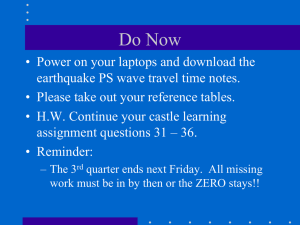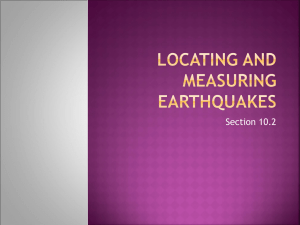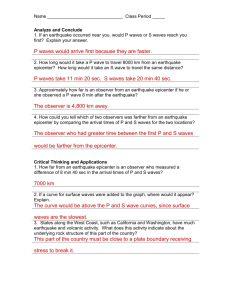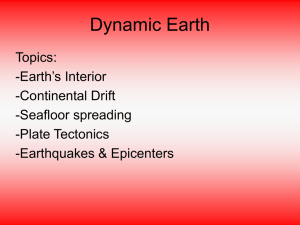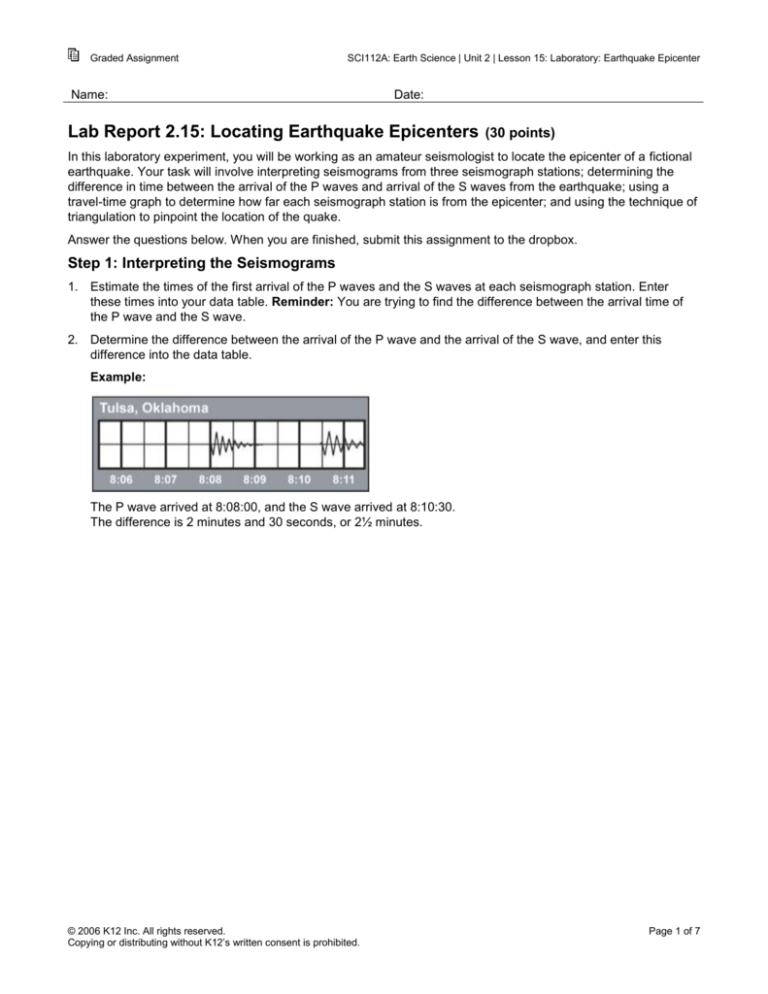
Graded Assignment
SCI112A: Earth Science | Unit 2 | Lesson 15: Laboratory: Earthquake Epicenter
Name:
Date:
Lab Report 2.15: Locating Earthquake Epicenters
(30 points)
In this laboratory experiment, you will be working as an amateur seismologist to locate the epicenter of a fictional
earthquake. Your task will involve interpreting seismograms from three seismograph stations; determining the
difference in time between the arrival of the P waves and arrival of the S waves from the earthquake; using a
travel-time graph to determine how far each seismograph station is from the epicenter; and using the technique of
triangulation to pinpoint the location of the quake.
Answer the questions below. When you are finished, submit this assignment to the dropbox.
Step 1: Interpreting the Seismograms
1. Estimate the times of the first arrival of the P waves and the S waves at each seismograph station. Enter
these times into your data table. Reminder: You are trying to find the difference between the arrival time of
the P wave and the S wave.
2. Determine the difference between the arrival of the P wave and the arrival of the S wave, and enter this
difference into the data table.
Example:
The P wave arrived at 8:08:00, and the S wave arrived at 8:10:30.
The difference is 2 minutes and 30 seconds, or 2½ minutes.
© 2006 K12 Inc. All rights reserved.
Copying or distributing without K12’s written consent is prohibited.
Page 1 of 7
Graded Assignment
SCI112A: Earth Science | Unit 2 | Lesson 15: Laboratory: Earthquake Epicenter
Step 2: Determining the Distance to the Epicenter
You now know the difference between the arrival of the first P wave and the first S wave for each seismic station.
Because the waves travel at a known speed, this interval can be converted to distance using the graph below.
Example:
The P wave arrived at 8:08:00, and the S wave arrived at 8:10:30.
The difference is 2 minutes and 30 seconds, or 2½ minutes.
S-P Wave Interval Chart
Find 2 minutes and 30 seconds on the chart, then drop down to the distance when you intersect the S-P wave
interval line = 1,600 km.
P Wave - S Wave Interval (Minutes)
3
2
S-P wave interval
1
0
0
100
200
300
400
500
600
700
800
900
1000 1100 1200 1300 1400 1500 1600 1700 1800 1900 2000
Distance
© 2006 K12 Inc. All rights reserved.
Copying or distributing without K12’s written consent is prohibited.
Page 2 of 7
Graded Assignment
SCI112A: Earth Science | Unit 2 | Lesson 15: Laboratory: Earthquake Epicenter
Reading the Graph: Tips and Practice
The major lines you read on the y-axis (vertical axis) are minutes. The minor lines are quarters of minutes.
Starting from 0, the first dotted line would be 15 seconds, then 30 seconds for second line, 45 seconds for the
third line, and then 1 minute for the next solid line.
The major lines you read on the x-axis (horizontal axis) are in kilometers. Each major line is 500 km. Each
dotted line is 250 km.
Here are a few to practice.
1 minute = ________ km
45 seconds = ________ km
2 minutes and 45 seconds = ________ km
Check your answers:
© 2006 K12 Inc. All rights reserved.
Copying or distributing without K12’s written consent is prohibited.
Page 3 of 7
Graded Assignment
SCI112A: Earth Science | Unit 2 | Lesson 15: Laboratory: Earthquake Epicenter
Step 3: Locating the Epicenter
1. Locate a seismograph station on the map.
2. Locate the scale on the map.
3. Place your drafting compass point at 0 on the scale and the compass pencil at the proper distance for a
seismograph station. Then, place your compass point on the seismograph station, and draw a circle around
the station. Make sure the circle has a radius equal to the distance between the station and the epicenter.
4. The line that you draw is the distance to the earthquake. The earthquake could have happened at any point
on the line. To triangulate the epicenter, repeat this process for each station (the information you just added to
your data table).
Example:
Circles are drawn around three stations. The intersection of the circle shows the location of the earthquake.
Your circles should come close to intersecting on a point, but they may not be exact.
© 2006 K12 Inc. All rights reserved.
Copying or distributing without K12’s written consent is prohibited.
Page 4 of 7
Graded Assignment
SCI112A: Earth Science | Unit 2 | Lesson 15: Laboratory: Earthquake Epicenter
Interpreting the Seismograms LAB REPORT (graded)
Below are the seismograms that arrived at three different seismograph stations located in Helena, Montana; San
Diego, California; and Dallas, Texas. When looking at wave arrival times in the seismograms, keep in mind that
BOLD lines represent minutes and the thinner lines between the bold ones represent 30 seconds after the minute
mark. A wave could also start at a point between the minute and 30 second mark, starting around 15 seconds or
45 seconds after the minute mark. Look at the data carefully when determining the time the waves start:
1)
Answer:
P Wave
Arrival
S Wave
Arrival
Difference Between the P and S Wave
Arrival Times (minutes)
Distance to Epicenter (km)
(convert minutes to distance using
the chart below)
S Wave
Arrival
Difference Between the P and S Wave
Arrival Times (minutes)
Distance to Epicenter (km)
2)
Answer:
P Wave
Arrival
© 2006 K12 Inc. All rights reserved.
Copying or distributing without K12’s written consent is prohibited.
Page 5 of 7
Graded Assignment
SCI112A: Earth Science | Unit 2 | Lesson 15: Laboratory: Earthquake Epicenter
3)
Answer:
P Wave
Arrival
S Wave
Arrival
Difference Between the P and S Wave
Arrival Times (minutes)
Distance to Epicenter (km)
S-P Wave Interval Chart
P Wave - S Wave Interval (Minutes)
3
2
1
0
0
100
200
300
400
500
600
700
800
900
1000 1100 1200 1300 1400 1500 1600 1700 1800 1900 2000
Distance
© 2006 K12 Inc. All rights reserved.
Copying or distributing without K12’s written consent is prohibited.
Page 6 of 7
Graded Assignment
SCI112A: Earth Science | Unit 2 | Lesson 15: Laboratory: Earthquake Epicenter
4) Map…Please mark your 3 circles w/ radius lines and show where the earthquake epicenter is on
the map below:
Directions for drawing (also refer to the practice example in the first part of the lab): Using the
drawing tools in Word or your OpenOffice program, draw a circle around each of the 3 stations. Make
sure you are drawing around the correct city (the city should be at the center of the circle). Make sure
the circle has a radius (half the distance across the center of a circle) equal to the distance between the
station and the epicenter, or the distances you found in 1-3. Use a straight line drawing tool to get the
radius line the right length using the kilometer scale on the bottom of the map. Then, position the radius
line so that one end touches the city and fit a circle around it, sizing the circle so that the city is in the
middle and the outside of the circle (circumference) extends out to the end of the radius line. Use
“INSERT->SHAPES” to select and draw a circles and lines.
Hint: The 3 circles should be touching/ overlapping and their circumferences will meet at one point to
triangulate the location of the earthquake epicenter!
© 2006 K12 Inc. All rights reserved.
Copying or distributing without K12’s written consent is prohibited.
Page 7 of 7


